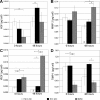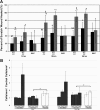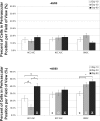Hypoxic culture and in vivo inflammatory environments affect the assumption of pericyte characteristics by human adipose and bone marrow progenitor cells
- PMID: 21865587
- PMCID: PMC3233793
- DOI: 10.1152/ajpcell.00460.2010
Hypoxic culture and in vivo inflammatory environments affect the assumption of pericyte characteristics by human adipose and bone marrow progenitor cells
Abstract
Previous studies have shown that exposure to a hypoxic in vitro environment increases the secretion of pro-angiogenic growth factors by human adipose-derived stromal cells (hASCs) [Cao Y, et al., Biochem Biophys Res Commun 332: 370-379, 2005; Kokai LE, et al., Plast Reconstr Surg 116: 1453-1460, 2005; Park BS, et al., Biomed Res (Tokyo) 31: 27-34, 2010; Rasmussen JG, et al., Cytotherapy 13: 318-328, 2010; Rehman J, et al., Circulation 109: 1292-1298, 2004]. Previously, it has been demonstrated that hASCs can differentiate into pericytes and promote microvascular stability and maintenance during angiogenesis in vivo (Amos PJ, et al., Stem Cells 26: 2682-2690, 2008; Traktuev DO, et al., Circ Res 102: 77-85, 2008). In this study, we tested the hypotheses that angiogenic induction can be increased and pericyte differentiation decreased by pretreatment of hASCs with hypoxic culture and that hASCs are similar to human bone marrow-derived stromal cells (hBMSCs) in these regards. Our data confirms previous studies showing that hASCs: 1) secrete pro-angiogenic proteins, which are upregulated following culture in hypoxia, and 2) migrate up gradients of PDGF-BB in vitro, while showing for the first time that a rat mesenteric model of angiogenesis induced by 48/80 increases the propensity of both hASCs and hBMSCs to assume perivascular phenotypes following injection. Moreover, culture of both cell types in hypoxia before injection results in a biphasic vascular length density response in this model of inflammation-induced angiogenesis. The effects of hypoxia and inflammation on the phenotype of adult progenitor cells impacts both the therapeutic and the basic science applications of the cell types, as hypoxia and inflammation are common features of natural and pathological vascular compartments in vivo.
Figures






Similar articles
-
IFATS collection: The role of human adipose-derived stromal cells in inflammatory microvascular remodeling and evidence of a perivascular phenotype.Stem Cells. 2008 Oct;26(10):2682-90. doi: 10.1634/stemcells.2008-0030. Epub 2008 Apr 24. Stem Cells. 2008. PMID: 18436860 Free PMC article.
-
Functional assessment of adipose stem cells for xenotransplantation using myocardial infarction immunocompetent models: comparison with bone marrow stem cells.Cell Biochem Biophys. 2013 Nov;67(2):263-73. doi: 10.1007/s12013-011-9323-0. Cell Biochem Biophys. 2013. PMID: 22205499
-
Hypoxia Inhibits De Novo Vascular Assembly of Adipose-Derived Stromal/Stem Cell Populations, but Promotes Growth of Preformed Vessels.Tissue Eng Part A. 2016 Jan;22(1-2):161-9. doi: 10.1089/ten.TEA.2015.0421. Epub 2015 Dec 9. Tissue Eng Part A. 2016. PMID: 26481655 Free PMC article.
-
The bone marrow constitutes a reservoir of pericyte progenitors.J Leukoc Biol. 2006 Oct;80(4):677-81. doi: 10.1189/jlb.0506309. Epub 2006 Aug 3. J Leukoc Biol. 2006. PMID: 16888086 Review.
-
Pericytes. Morphofunction, interactions and pathology in a quiescent and activated mesenchymal cell niche.Histol Histopathol. 2009 Jul;24(7):909-69. doi: 10.14670/HH-24.909. Histol Histopathol. 2009. PMID: 19475537 Review.
Cited by
-
Fluoxetine Decreases the Proliferation and Adipogenic Differentiation of Human Adipose-Derived Stem Cells.Int J Mol Sci. 2015 Jul 22;16(7):16655-68. doi: 10.3390/ijms160716655. Int J Mol Sci. 2015. PMID: 26204837 Free PMC article.
-
Pericyte dynamics during angiogenesis: new insights from new identities.J Vasc Res. 2014;51(3):163-74. doi: 10.1159/000362276. Epub 2014 May 17. J Vasc Res. 2014. PMID: 24853910 Free PMC article. Review.
-
Pericyte derivation and transplantation for blood-CNS barrier reconstitution in CNS disorders.IBRO Neurosci Rep. 2024 Jan 3;16:147-154. doi: 10.1016/j.ibneur.2023.12.007. eCollection 2024 Jun. IBRO Neurosci Rep. 2024. PMID: 39007089 Free PMC article.
-
Vascular morphogenesis of adipose-derived stem cells is mediated by heterotypic cell-cell interactions.Tissue Eng Part A. 2012 Aug;18(15-16):1729-40. doi: 10.1089/ten.tea.2011.0599. Epub 2012 May 9. Tissue Eng Part A. 2012. PMID: 22462659 Free PMC article.
-
Efficiency assessment of irrigation as an alternative method for improving the regenerative potential of non-healing wounds.Wound Repair Regen. 2022 May;30(3):303-316. doi: 10.1111/wrr.13013. Wound Repair Regen. 2022. PMID: 35384136 Free PMC article.
References
-
- Armulik A, Abramsson A, Betsholtz C. Endothelial/pericyte interactions. Circ Res 97: 512–523, 2005 - PubMed
-
- Cao Y, Sun Z, Liao L, Meng Y, Han Q, Zhao RC. Human adipose tissue-derived stem cells differentiate into endothelial cells in vitro and improve postnatal neovascularization in vivo. Biochem Biophys Res Commun 332: 370–379, 2005 - PubMed
Publication types
MeSH terms
Grants and funding
LinkOut - more resources
Full Text Sources
Other Literature Sources
Medical

